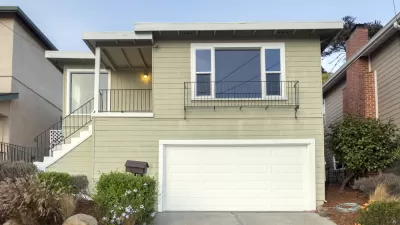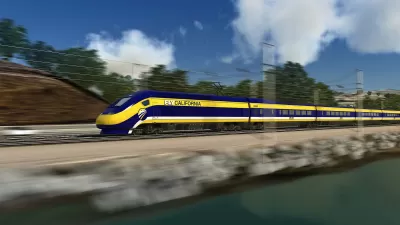Jerry Brown signed a $156.3-billion budget on June 20 that marks a new day for greenhouse gas-reducing transportation and sustainable communities projects due to new revenues from the state's cap and trade market now and, particularly, in the future.

While the controversial $250 million for the embattled San Francisco to Los Angeles bullet train received from cap and trade much attention in the mainstream media, allocations to transit, affordable housing and other categories received much less attention except in the nonprofit world where groups fiercely fought for them. Stuart Cohen, executive director of TransForm, lists the winners outside of high speed rail for the fiscal year that begins July 1:
- $25M for Transit and Intercity Rail Capital Program;
- $25M for Low Carbon Transit Operations;
- $65M for Affordable Housing;
- $65M for Sustainable Communities; and
- $200M for Low Carbon Transportation.
These cap and trade revenues are not like other budgetary items where the governor and legislature squabble annually over how much to allocate. Sixty percent of future revenues - and they are expected to grow substantially as more industries "fall under the cap", will be split by three categories:
- 25% for High Speed Rail on an annual basis
- 35% to the Sustainable Communities Program and transit on an annual basis into the following groups:
- 10% for Transit and Intercity Rail Capital Program;
- 5% for Low Carbon Transit Operations; and
- 20% for Affordable Housing and Sustainable Communities [See below for more detail].
That leaves 40% of revenue that is discretionary. Cohen suggests beneficiaries could be Low-Carbon Transportation, Energy Efficiency, Urban Forestry, Forestry, Water, and Waste.
Amanda Eaken of NRDC includes a pie chart of the first year allocation and future allocations in her blog about how the new budget implements "California’s landmark Sustainable Communities and Climate Protection Law (SB 375), both this year and into the future."
Eaken describes the sustainable communities breakdown:
- 20% for housing and sustainable communities (including planning, active transportation, transit and other supportive infrastructure, and not less than half for housing) – administered by the Strategic Growth Council and the Air Resources Board.
Just how much revenue are we talking about here? AP reporter Juliet Williams writes that the single largest category, high speed rail, could receive a whopping "$3 billion to $5 billion a year in coming years" from the cap and trade fund, at least through 2020 which is when the law that authorizes it, AB 32 expires.
One important caveat: litigation. This is California, after all.
FULL STORY: Legislature reaches landmark budget agreement on cap-and-trade

Maui's Vacation Rental Debate Turns Ugly
Verbal attacks, misinformation campaigns and fistfights plague a high-stakes debate to convert thousands of vacation rentals into long-term housing.

Planetizen Federal Action Tracker
A weekly monitor of how Trump’s orders and actions are impacting planners and planning in America.

In Urban Planning, AI Prompting Could be the New Design Thinking
Creativity has long been key to great urban design. What if we see AI as our new creative partner?

King County Supportive Housing Program Offers Hope for Unhoused Residents
The county is taking a ‘Housing First’ approach that prioritizes getting people into housing, then offering wraparound supportive services.

Researchers Use AI to Get Clearer Picture of US Housing
Analysts are using artificial intelligence to supercharge their research by allowing them to comb through data faster. Though these AI tools can be error prone, they save time and housing researchers are optimistic about the future.

Making Shared Micromobility More Inclusive
Cities and shared mobility system operators can do more to include people with disabilities in planning and operations, per a new report.
Urban Design for Planners 1: Software Tools
This six-course series explores essential urban design concepts using open source software and equips planners with the tools they need to participate fully in the urban design process.
Planning for Universal Design
Learn the tools for implementing Universal Design in planning regulations.
planning NEXT
Appalachian Highlands Housing Partners
Mpact (founded as Rail~Volution)
City of Camden Redevelopment Agency
City of Astoria
City of Portland
City of Laramie




























